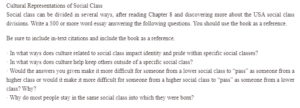Cultural Representation of Social Class
Social stratification is how society categorizes people based on socioeconomic factors and access to valued resources such as wealth, power, and prestige. The world has been going through this social class division since historically, and it was invented by two sociologists, Dennis Gilbert and Joseph Kahl. They developed a social class model consisting of six classes: the capitalist class, upper middle class, lower middle class, working class, working poor, and the underclass. The USA has been following these categorizations for centuries, and it causes more division among people than racism, politics, and more.
Historically, the culture used has affected the world today since they used two types of social stratification systems: closed and open. The designs can be found in some parts of the world today, whereby the secure system mainly means that there is little to no chance for someone to move out of the social class they were born into, and examples are slavery and castes. In the open system, one can change the social type they were born into if they work harder, make choices, and take risks.
Slavery was a regular activity historically, but now it is scarce and only available in a few countries even after the United Nations banned slavery, such as China, India, Pakistan, Uzbekistan, and Russia since around 36 million people around the world are living as enslaved people with only 60% coming from these countries (Benokraitis, n.d.). Today, in the United States, the open system is used, and some people are classified according to wealth, income, education, social status, and how they obtain a livelihood.
Culture keeps people outside of a specific social class since people have beliefs and cultural norms that if born into an upper class, they will grow into an upper class. Therefore, since the gap between the rich and poor is ever-growing, it becomes psychological for the poor that they cannot achieve what the rich have, and the rich cannot become poor once they are born rich. Furthermore, children born into wealthy families go to the best schools since their parents have enough resources to pay for their education. In contrast, poor or middle-class children can only depend on themselves for success.
Consequently, it is more complicated for someone from a lower social class to “pass” as someone from a higher social class since taller social class people gain many privileges due to their wealth, income, and occupations. It is easier for them to get what they want and get praised than middle to lower-class people who may not appear necessary. For instance, it is easier for high-income earners to access basic needs like good health than low-income earners like high school janitors. Western cultures have shown that upper-class individuals have better mental and physical health than lower and middle-class individuals (Miyamoto, 2017). Thus, the lower people are on the ranking scale, the harder they can climb due to bills, expenses, inadequate education, etc.
In conclusion, people stay in the same social class as they were born due to social norms. People become hopeless and let their fears of failing and lack of resources prevent them from growing. However, some people were taken into low-class and low-income families but now belong to the upper class since they strived for their goals and had a positive mindset. Lastly, social class division is not a healthy habit, and therefore, all human beings should join hands and help each other since combining efforts portrays better skills and power.
References
Benokraitis, N. (n.d.). SOC 6.
Miyamoto, Y. (2017). Culture and social class. Current Opinion in Psychology, 18, 67-72. https://doi.org/10.1016/j.copsyc.2017.07.042
ORDER A PLAGIARISM-FREE PAPER HERE
We’ll write everything from scratch
Question

Cultural Representation of Social Class
Cultural Representations of Social Class
After reading Chapter 8 and discovering more about the USA social class divisions, social class can be divided in several ways. Write a 500 or more word essay answering the following questions. It would be best if you used the book as a reference.
Be sure to include in-text citations and include the book as a reference.
In what ways does culture related to social class impact identity and pride within specific social classes?
In what ways does culture help keep others outside of a specific social class?
Would the answers you gave make it more difficult for someone from a lower social class to “pass” as someone from a higher rank, or would it make it more difficult for someone from a higher social class to “pass” as someone from a lower class? Why?
· Why do most people stay in the same social class they were born in?


